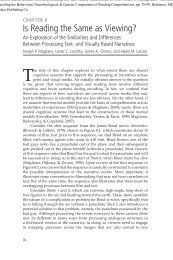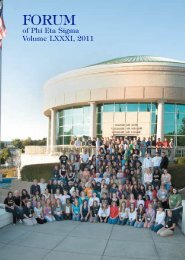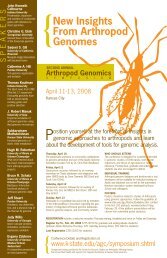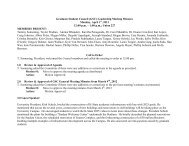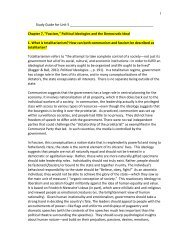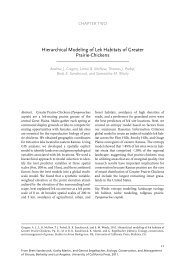Status Report, Vol. 36, No. 7, July 28, 2001 - Insurance Institute for ...
Status Report, Vol. 36, No. 7, July 28, 2001 - Insurance Institute for ...
Status Report, Vol. 36, No. 7, July 28, 2001 - Insurance Institute for ...
Create successful ePaper yourself
Turn your PDF publications into a flip-book with our unique Google optimized e-Paper software.
6 <strong>Status</strong> <strong>Report</strong>, <strong>Vol</strong>. <strong>36</strong>, <strong>No</strong>. 7, <strong>July</strong> <strong>28</strong>, <strong>2001</strong><br />
stalled...”. What movement is he referring<br />
to? In the 1970s many states were repealing<br />
motorcycle helmet use laws, which<br />
were proven to reduce motorcyclist<br />
deaths, but there was no movement to<br />
pass seat belt use laws as early as the<br />
1970s. Safety advocates including Haddon<br />
went on record in support of such laws.<br />
The federal government had some incentive<br />
grants available to any states that<br />
passed such laws. But there was no real<br />
movement and no progress toward seat<br />
belt use laws until the mid-1980s.<br />
It is absurd to claim that “if [Ralph]<br />
Nader had advocated mandatory belt laws<br />
they might have carried the day.” Does<br />
anyone believe politicians who voted to repeal<br />
helmet laws would have changed<br />
their minds and voted <strong>for</strong> seat belt laws<br />
because Nader asked them to?<br />
Even today, most states have weak belt<br />
laws with significant gaps in coverage, minimum<br />
penalties, and en<strong>for</strong>cement only if<br />
another traffic violation has been observed.<br />
Only a few jurisdictions have good<br />
laws and politicians who encourage ef<strong>for</strong>ts<br />
to get more motorists to buckle up.<br />
The contrast with other countries is obvious.<br />
In Canada, <strong>for</strong> example, belt use exceeds<br />
90 percent in all provinces, a rate<br />
achieved by good seat belt use laws together<br />
with well-publicized en<strong>for</strong>cement.<br />
In the United States belt use rates range<br />
from below 50 percent in <strong>No</strong>rth Dakota to<br />
about 90 percent in Cali<strong>for</strong>nia. Our generally<br />
dismal record with respect to belt use —<br />
compared with Canada, northern Europe,<br />
Australia, and a number of other countries<br />
— has nothing to do with a “wrong turn” in<br />
U.S. policy. It has to do with the failure of<br />
political leadership in many states.<br />
Most highway safety measures that can<br />
successfully change road user behavior are<br />
implemented at the state level. Since the<br />
mid-1970s the federal safety program has<br />
been able to do little more than encourage<br />
appropriate state action. The balanced<br />
program Haddon and others supported in<br />
the late 1960s envisaged a much more direct<br />
federal role. Setting aside issues of<br />
federal versus state responsibilities, the<br />
undeniable fact is that the original federal<br />
role would have resulted in more<br />
progress in highway safety than has<br />
been accomplished.<br />
“In 1959, Haddon [shown left] and I organized<br />
a conference, perhaps the first ever on<br />
As to Gladwell’s section on<br />
seat belts and airbags, he<br />
needs a lesson in restraint system<br />
per<strong>for</strong>mance and design. .... By the mid-nineteen-sixties, we had an<br />
automobile trauma as a public health issue<br />
He claims “that even today it agency with Haddon as its head. The issue had<br />
is seat belts, not airbags, that been correctly defined. This is what mattered,<br />
are providing the most impor- not the ups and downs that followed. Fifty years<br />
ago, cars didn’t have ‘crashes.’ Drivers had<br />
‘accidents.’ Haddon did this.” — Former<br />
U.S. Senator Daniel Patrick Moynihan, letter<br />
to The New Yorker, <strong>July</strong> 9, <strong>2001</strong><br />
tant new safety advances.” He apparently<br />
is unaware that belt pretensioners are only<br />
possible because they use the same technology<br />
as airbags. He doesn’t seem to be<br />
aware that belt <strong>for</strong>ce limiters, which allow<br />
belts to “pay out” extra webbing to reduce<br />
chest loads also are possible only with<br />
airbags. Without airbags, belt <strong>for</strong>ce limiters<br />
would allow drivers’ faces to strike<br />
the steering wheels in many crashes. Today<br />
all auto manufacturers are designing<br />
their seat belts and airbags to work together<br />
as a single system to optimize occupant<br />
protection in crashes.<br />
Finally, Gladwell describes<br />
a crash involving Robert Day<br />
and others, claiming Day’s<br />
“best chance” of surviving<br />
“would have been to wear his<br />
seat belt.” Day was in a side<br />
impact, during which Gladwell<br />
says “the door was<br />
driven into him like a sledgehammer.”<br />
This is a crash<br />
circumstance when a belt almost<br />
certainly would have<br />
provided no benefit. Day<br />
would have been much more<br />
likely to benefit from a side<br />
impact torso airbag and/or<br />
improved side vehicle structure — the<br />
kinds of technologies Gladwell dismisses.<br />
I had the privilege of working closely<br />
with Bill Haddon longer than perhaps anyone,<br />
from 1969 until his premature death in<br />
1985. Gladwell’s portrait is a distortion of<br />
the man and his views. The article fails to<br />
communicate the true scope of the original<br />
federal motor vehicle safety standards<br />
shepherded by Haddon. In addition, it<br />
hopelessly misrepresents the successful<br />
history of highway and motor vehicle safety<br />
ef<strong>for</strong>ts during the last three and half<br />
decades of the 20th century.



